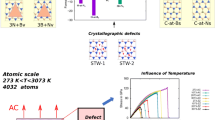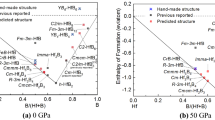Abstract
Hafnium diboride (HfB2) is an important metallic ceramic that works in harsh environments, due to its high strength and thermal conductivity. Although the thermal conductivity of HfB2 has been measured, the experimental results are scattered. Also, the thermal transport mechanism of HfB2 is not well understood. In this work, we study the thermal transport in both pristine and defective HfB2 from first-principles calculations. For the pristine HfB2, the room-temperature thermal conductivities are 175.0 and 157.7 W·m−1·K−1 on a- and c-axes, respectively, where the contributions from electron and phonon are comparable. The Lorenz number is significantly smaller than the Sommerfeld value and shows a temperature dependence, which demonstrates that the Wiedemann–Franz law cannot be used to estimate electronic thermal conductivity. The phonon–isotope and the phonon–electron scattering are non-negligible compared to the phonon–phonon scattering. For the defective HfB2, the grain size effects are negligible with length scales larger than 1 μm. The pore can limit thermal conductivity when its occupancy is larger than 10%. The vacancy is found to induce scattered results in experiments. The phonon thermal conductivity significantly reduces even with only 1% vacancy, while the electronic thermal conductivity is not sensitive to the vacancy. Our study provides an in-depth understanding of the thermal transport in HfB2, and the revealed mechanisms provide important guidance on the design of HfB2-based materials.
Graphical Abstract

摘要
二硼化铪(HfB2)是一种重要的,可以在恶劣的环境中工作的金属陶瓷。这是因为其拥有高强度和高热导率。 然而尽管已有实验上测得的热导率实验数据,测量的结果数据却是不一致的。另一方面,二硼化铪的热输运机 制也尚未充分理解。在本研究中,我们通过第一原理计算研究了本征的和含缺陷的二硼化铪的热输运。研究表 明,对于本征二硼化铪,室温下a 轴和c 轴上的热导率为 175.0 和 157.7 W·m‒1·K‒1,且电子和声子对导热的贡 献相当。电子导热分析中,发现洛伦兹数明显小于索末菲值且表现出温度依赖性,这表明魏德曼–夫兰兹定理不 适用于估算电子热导率。电子导热分析中,则发现声子-同位素散射,声子-电子散射与声子-声子散射相当,因 而不可忽略。缺陷对热导率影响的研究中发现,当晶粒尺寸大于 1 μm 的情况下,晶界对热导率的影响可以忽 略。宏观的孔隙率高于 10%时,热导率会显著下降。实验上不一致的测量结果则主要是由原子空位所导致的。 即使只有 1%的原子空位,声子热导率也会明显降低;而电子热导率则对原子空位不敏感。本研究深入理解了二 硼化铪中的导热机制,并为二硼化铪相关的材料设计提供了重要指导。







Similar content being viewed by others
References
Savino R, De Stefano FM, Silvestroni L, Sciti D. Arc-jet testing on HfB2 and HfC-based ultra-high temperature ceramic materials. J Eur Ceram Soc. 2008;28(9):1899. https://doi.org/10.1016/j.jeurceramsoc.2007.11.021.
Opeka MM, Talmy IG, Wuchina EJ, Zaykoski JA, Causey SJ. Mechanical, thermal, and oxidation properties of refractory hafnium and zirconium compounds. J Eur Ceram Soc. 1999;19(13):2405. https://doi.org/10.1016/S0955-2219(99)00129-6.
Zapata-Solvas E, Moshtaghioun BM, Gómez-García D, Domínguez-Rodríguez A, Lee WE. HfB2 ceramic polycrystals: a low-temperature metal-like ceramic at high temperatures? Scripta Mater. 2021;203:114037. https://doi.org/10.1016/j.scriptamat.2021.114037.
Liang H, Sun W, Li X, Chen H, Guan S, Liu P, Wang Q, Li X, He D, Peng F. Study of the compression behavior and elastic properties of HfB2 ceramics using experimental method and first-principles calculations. J Alloys Compd. 2019;808:151764. https://doi.org/10.1016/j.jallcom.2019.151764.
Fahrenholtz WG, Hilmas GE, Talmy IG, Zaykoski JA. Refractory diborides of Zirconium and Hafnium. J Am Ceram Soc. 2007;90(5):1347. https://doi.org/10.1111/j.1551-2916.2007.01583.x.
Squire TH, Marschall J. Material property requirements for analysis and design of UHTC components in hypersonic applications. J Eur Ceram Soc. 2010;30(11):2239. https://doi.org/10.1016/j.jeurceramsoc.2010.01.026.
Larrimbe L, Pettinà M, Nikbin K, Jones EL, Katz AP, Hawkins CJ, DeCerbo J, Brown P, Vandeperre LJ. High heat flux laser testing of HfB2 cylinders. J Am Ceram Soc. 2017;100(1):293. https://doi.org/10.1111/jace.14474.
Zhang L, Pejaković DA, Marschall J, Gasch M. Thermal and electrical transport properties of spark plasma-sintered HfB2 and ZrB2 ceramics. J Am Ceram Soc. 2011;94(8):2562. https://doi.org/10.1111/j.1551-2916.2011.04411.x.
Lawson JW, Daw MS, Bauschlicher CW. Lattice thermal conductivity of ultra high temperature ceramics ZrB2 and HfB2 from atomistic simulations. J Appl Phys. 2011;110(8):083507. https://doi.org/10.1063/1.3647754.
Branscomb TM, Hunter O. Improved thermal diffusivity method applied to TiB2, ZrB2, and HfB2 from 200 to 1300°C. J Appl Phys. 1971;42(6):2309. https://doi.org/10.1063/1.1660541.
Loehman RE, Corral EL, Dumm HP, Kotula PG, Tandon R. Ultra high temperature ceramics for hypersonic vehicle applications. Sandia National Laboratories, Albuquerque New Mexico, and Livermore California; 2006. https://doi.org/10.2172/887260
Gasch M, Johnson S, Marschall J. Thermal conductivity characterization of hafnium diboride-based ultra-high-temperature ceramics. J Am Ceram Soc. 2008;91(5):1423. https://doi.org/10.1111/j.1551-2916.2008.02364.x.
Tritt TM, editor. Thermal conductivity: theory, properties, and applications. Springer, New York: Springer; 2005. p. 2005.
Zhang ZM. Nano/microscale heat transfer. Switzerland: Springer; 2020.
Chester GV, Thellung A. The Law of Wiedemann and Franz. Proceedings of the Physical Society. 1961;77(5):1005. https://doi.org/10.1088/0370-1328/77/5/309.
Tong Z, Li S, Ruan X, Bao H. Comprehensive first-principles analysis of phonon thermal conductivity and electron-phonon coupling in different metals. Phys Rev B. 2019;100(14):144306. https://doi.org/10.1103/PhysRevB.100.144306.
Wang A, Li S, Zhang X, Bao H. Roles of electrons on the thermal transport of 2D metallic MXenes. Phys Rev Mater. 2022;6(1):014009. https://doi.org/10.1103/PhysRevMaterials.6.014009.
Li S, Wang A, Hu Y, Gu X, Tong Z, Bao H. Anomalous thermal transport in metallic transition-metal nitrides originated from strong electron–phonon interactions. Mater Today Phys. 2020;15:100256. https://doi.org/10.1016/j.mtphys.2020.100256.
Zhang X, Li S, Wang A, Bao H. Pressure-dependent thermal conductivity in Al, W, and Pt: role of electrons and phonons. Phys Rev B. 2022;106(9):094313. https://doi.org/10.1103/PhysRevB.106.094313.
Sonar V, Dehankar R, Vijayalakshmi KP, Mingo N, Katre A. Site-independent strong phonon-vacancy scattering in high-temperature ceramics ZrB2 and HfB2. Phys Rev Mater. 2022;6(6):065403. https://doi.org/10.1103/PhysRevMaterials.6.065403.
Jain A, McGaughey AJH. Thermal transport by phonons and electrons in aluminum, silver, and gold from first principles. Phys Rev B. 2016;93(8):081206. https://doi.org/10.1103/PhysRevB.93.081206.
Bao H, Chen J, Gu X, Cao B. A review of simulation methods in micro/nanoscale heat conduction. ES Energy Environ. 2018;1:16. https://doi.org/10.30919/esee8c149.
Li S, Tong Z, Zhang X, Bao H. Thermal conductivity and Lorenz ratio of metals at intermediate temperatures with mode-level first-principles analysis. Phys Rev B. 2020;102(17):174306. https://doi.org/10.1103/PhysRevB.102.174306.
Liu T-H, Zhou J, Li M, Ding Z, Song Q, Liao B, Fu L, Chen G. Electron mean-free-path filtering in Dirac material for improved thermoelectric performance. Proc Natl Acad Sci. 2018;115(5):879. https://doi.org/10.1073/pnas.1715477115.
Chen G. Nanoscale energy transport and conversion: a parallel treatment of electrons, molecules, phonons, and photons. Oxford: Oxford University Press; 2005. p. 27.
Bardeen J, Pines D. Electron-phonon interaction in metals. Phys Rev. 1955;99(4):1140. https://doi.org/10.1103/PhysRev.99.1140.
Langer JS. Theory of impurity resistance in metals. Phys Rev. 1960;120(3):714. https://doi.org/10.1103/PhysRev.120.714.
Rice TM. The effects of electron-electron interaction on the properties of metals. Ann Phys. 1965;31(1):100. https://doi.org/10.1016/0003-4916(65)90234-4.
Lavasani A, Bulmash D, Das SS. Wiedemann-Franz law and Fermi liquids. Phys Rev B. 2019;99(8):085104. https://doi.org/10.1103/PhysRevB.99.085104.
Li W, Carrete J, Katcho NA, Mingo N. Sheng BTE: a solver of the Boltzmann transport equation for phonons. Comput Phys Commun. 2014;185(6):1747. https://doi.org/10.1016/j.cpc.2014.02.015.
Ziman JM. Electrons and phonons: the theory of transport phenomena in solids. Oxford: Oxford University Press; 2001. p. 285.
Mizutani U. Introduction to the electron theory of metals. Cambridge: Cambridge University Press; 2001.
Hummel RE. Electronic properties of materials. New York: Springer; 2011.
Kittel C. Introduction to solid state physics. New York: John Wiley & sons, inc.; 2005. p. 140.
Gantmakher V, Levinson Y. Carrier scattering in metals and semiconductors. North Holland: Elsevier; 2012.
Schiff LI. Quantum mechanics. New York: McGraw-Hill; 1955. p. 205.
Xie G, Shen Y, Wei X, Yang L, Xiao H, Zhong J, Zhang G. A bond-order theory on the phonon scattering by vacancies in two-dimensional materials. Sci Rep. 2014;4(1):5085. https://doi.org/10.1038/srep05085.
Protik NH, Carrete J, Katcho NA, Mingo N, Broido D. Ab initio study of the effect of vacancies on the thermal conductivity of boron arsenide. Phys Rev B. 2016;94(4):045207. https://doi.org/10.1103/PhysRevB.94.045207.
Klemens PG. Phonon scattering by oxygen vacancies in ceramics. Physica B. 1999;263:102. https://doi.org/10.1016/S0921-4526(98)01202-2.
Tamura S-i. Isotope scattering of dispersive phonons in Ge. Phys Rev B. 1983;27(2):858. https://doi.org/10.1103/PhysRevB.27.858.
Giannozzi P, Baroni S, Bonini N, Calandra M, Car R, Cavazzoni C, Ceresoli D, Chiarotti GL, Cococcioni M, Dabo I, Dal Corso A, de Gironcoli S, Fabris S, Fratesi G, Gebauer R, Gerstmann U, Gougoussis C, Kokalj A, Lazzeri M, Martin-Samos L, Marzari N, Mauri F, Mazzarello R, Paolini S, Pasquarello A, Paulatto L, Sbraccia C, Scandolo S, Sclauzero G, Seitsonen AP, Smogunov A, Umari P, Wentzcovitch RM. QUANTUM ESPRESSO: a modular and open-source software project for quantum simulations of materials. J Phys Condens Matter. 2009;21(39):395502. https://doi.org/10.1088/0953-8984/21/39/395502.
Hamann DR. Optimized norm-conserving Vanderbilt pseudopotentials. Phys Rev B. 2013;88(8):085117. https://doi.org/10.1103/PhysRevB.88.085117.
Perdew JP, Burke K, Ernzerhof M. Generalized gradient approximation made simple. Phys Rev Lett. 1996;77(18):3865. https://doi.org/10.1103/PhysRevLett.77.3865.
Baroni S, de Gironcoli S, Dal Corso A, Giannozzi P. Phonons and related crystal properties from density-functional perturbation theory. Rev Mod Phys. 2001;73(2):515. https://doi.org/10.1103/RevModPhys.73.515.
Poncé S, Margine ER, Verdi C, Giustino F. EPW: electron–phonon coupling, transport and superconducting properties using maximally localized Wannier functions. Comput Phys Commun. 2016;209:116. https://doi.org/10.1016/j.cpc.2016.07.028.
Mostofi AA, Yates JR, Lee Y-S, Souza I, Vanderbilt D, Marzari N. wannier90: a tool for obtaining maximally-localised Wannier functions. Comput Phys Commun. 2008;178(9):685. https://doi.org/10.1016/j.cpc.2007.11.016.
Broido DA, Malorny M, Birner G, Mingo N, Stewart DA. Intrinsic lattice thermal conductivity of semiconductors from first principles. Appl Phys Lett. 2007;91(23):231922. https://doi.org/10.1063/1.2822891.
Han Z, Yang X, Li W, Feng T, Ruan X. FourPhonon: An extension module to ShengBTE for computing four-phonon scattering rates and thermal conductivity. Comput Phys Commun. 2022;270:108179. https://doi.org/10.1016/j.cpc.2021.108179.
Feng T, Ruan X. Quantum mechanical prediction of four-phonon scattering rates and reduced thermal conductivity of solids. Phys Rev B. 2016;93(4):045202. https://doi.org/10.1103/PhysRevB.93.045202.
Feng T, Lindsay L, Ruan X. Four-phonon scattering significantly reduces intrinsic thermal conductivity of solids. Phys Rev B. 2017;96(16):161201. https://doi.org/10.1103/PhysRevB.96.161201.
Gasch MJ, Ellerby DT, Johnson SM. Ultra High Temperature Ceramic Composites. In: Bansal NP, editor. Handbook of Ceramic Composites. Boston: Springer; 2005.
Vajeeston P, Ravindran P, Ravi C, Asokamani R. Electronic structure, bonding, and ground-state properties of AlB2-type transition-metal diborides. Phys Rev B. 2001;63(4):045115. https://doi.org/10.1103/PhysRevB.63.045115.
Deligoz E, Colakoglu K, Ciftci YO. Lattice dynamical and thermodynamical properties of HfB2 and TaB2 compounds. Comput Mater Sci. 2010;47(4):875. https://doi.org/10.1016/j.commatsci.2009.11.017.
Lawson JW, Bauschlicher CW Jr, Daw MS. Ab Initio Computations of Electronic, Mechanical, and Thermal Properties of ZrB2 and HfB2. J Am Ceram Soc. 2011;94(10):3494. https://doi.org/10.1111/j.1551-2916.2011.04649.x.
Bruggeman DAG. Berechnung verschiedener physikalischer Konstanten von heterogenen Substanzen. II. Dielektrizitätskonstanten und Leitfähigkeiten von Vielkristallen der nichtregulären Systeme. Ann Phys. 1936;417(7):645. https://doi.org/10.1002/andp.19364170706.
Buldu-Akturk M, Balcı-Çağıran Ö, Erdem E. EPR investigation of point defects in HfB2 and their roles in supercapacitor device performances. Appl Phys Lett. 2022;120(15):153901. https://doi.org/10.1063/5.0089931.
Acknowledgements
This work was financially supported by the National Natural Science Foundation of China (NSFC) (No. 52122606). S.-H. Li acknowledges the support by Shanghai Municipal Natural Science Foundation (No. 22YF1400100) and the Fundamental Research Funds for the Central Universities (No. 2232022D-22). Simulations were performed on the π 2.0 cluster supported by the Center for High Performance Computing at Shanghai Jiao Tong University.
Author information
Authors and Affiliations
Corresponding author
Ethics declarations
Conflict of interests
The authors declare that they have no conflict of interest.
Rights and permissions
Springer Nature or its licensor (e.g. a society or other partner) holds exclusive rights to this article under a publishing agreement with the author(s) or other rightsholder(s); author self-archiving of the accepted manuscript version of this article is solely governed by the terms of such publishing agreement and applicable law.
About this article
Cite this article
Wang, A., Li, SH. & Bao, H. Thermal transport mechanism of electrons and phonons in pristine and defective HfB2. Rare Met. 42, 3651–3661 (2023). https://doi.org/10.1007/s12598-023-02354-5
Received:
Revised:
Accepted:
Published:
Issue Date:
DOI: https://doi.org/10.1007/s12598-023-02354-5




